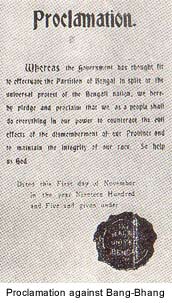

 |  |
 In December 1903, the partition proposals became publicly known. An immediate and spontaneous protest followed. The strength of this protest can be gauged from the fact that in the first two months following the announcement 500 protest meetings were held in East Bengal alone, especially in Dhaka, Mymensingh and Chittagong. Nearly fifty thousand copies of pamphlets giving a detailed critique of the partition proposals were distributed all over Bengal. In December 1903, the partition proposals became publicly known. An immediate and spontaneous protest followed. The strength of this protest can be gauged from the fact that in the first two months following the announcement 500 protest meetings were held in East Bengal alone, especially in Dhaka, Mymensingh and Chittagong. Nearly fifty thousand copies of pamphlets giving a detailed critique of the partition proposals were distributed all over Bengal. Surendranath Banerjea, Krishna Kumar Mitra, Prithwishchandra Ray and other leaders launched a powerful press campaign against the partition proposals through journals and newspapers like the Bengalee, Hitabadi and Sanjibani. Vast protest meetings were held in the town hall of Calcutta in March 1904 and January 1905, and numerous petitions (sixty nine memoranda from the Dhaka division alone), some of them signed by as many as 70,000 people - a very large number keeping in view the level of politicization in those days - were sent to the Government of India and the secretary of the state. Even, the big zamindars who had hitherto been loyal to the Raj, joined forces with the Congress leaders who were mostly intellectuals and political workers drawn from journalism, law and other liberal professions. The Government of India, however, remained unmoved. Despite the widespread protest voiced against the partition proposals, the decision to partition Bengal was announced on 19th July 1905. It was obvious to the nationalists that their moderate methods were not working and that a different kind of strategy was needed. Within days of the government announcement numerous spontaneous protest meetings were held in mofussil towns such as Dinajpur, Pabna, Faridpur, Tangail, Jessore, Dhaka, Birbhum and Barisal. It was in these meetings that the pledge to boycott foreign goods was first taken. In Calcutta, students organized a number of meetings against the partition and for Swadeshi. next page >> |
Copyright ©2000 indiansaga.info. All rights reserved.
By using this service, you accept that you won't copy or use the data given in this website for any commercial purpose.
The material on indiansaga.info is for informational & educational purpose only.
This site is best viewed at 800 X 600 picture resolution.